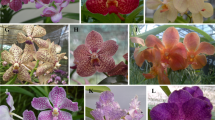Abstract
Four parameters, three hormones and sucrose, at seven concentrations, were designed for shoot proliferation of Penthorum chinense by uniform design. The obtained data were used for building two quadratic polynomial equations by partial least square to determine optimum concentrations of four factors. Experiments for verification confirmed that no significant difference existed between the predicted and the validated values in shoot number and length based on all inoculated explants.

Similar content being viewed by others
References
Cao H, Yang J, Peng ZS, Kang CY, Chen DC, Gong ZC, Tan X (2007) Micro-propagation of Penthorum chinense through axillary bud. In Vitro Cell Dev Biol Plant 43:149–153
Kang BH, Ryoo IJ, Park DJ, Lee HS (1996) Screening of biologically active compounds from various weeds. Agric Chem Biotechnol 39:409–413
Mahesh T, Menon VP (2004) Quercetin alleviates oxidative stress in strep-tozotocin-induced diabetic rats. Phytother Res 18:123–127
Moon YJ, Wang X, Morris ME (2006) Dietary flavonoids: effects on xenobiotic and carcinogen metabolism. Toxicol In Vitro 20:187–210
Murashige T, Skoog F (1962) A revised medium for rapid growth and bio-assays with tobacco tissue culture. Physiol Plant 15:473–497
Pan JT (1992) Delectis florae reipublicae popularis sinicae agendae academiae sinicae edita, vol 34, Flora Peipublicae Popularis Sinices. Science Press, Beijing, pp 2–3
Sigurdsson S, Ogmundsdottir HM, Hallgrimsson J, Gudbjarnason S (2005) Anti-tumour activity of Angelica archangelica leaf extract. In Vivo 19:191–194
Tang QY, Tang J (2005) Application of partial least-squares regressive on modeling analysis of uniform design experiment. Appl Stat Manage 5:45–49
Tang QY, Feng MG (2006) Data processing system: experimental design, statistical analysis and modeling. Science Press, Beijing, pp 253–254, 600–602, 598–599
Wang FQ, Gao CJ, Yang CY, Xu P (2007) Optimization of an ethanol production medium in very high gravity fermentation. Biotechnol Lett 29:233–236
Wei FL, Zhu GN (2006) Using uniform design and partial least-squares regression to prepare hypertonic emulsifiable concentrates. Agrochemicals 45(6):387–396
Xu CP, Yun JW (2003) Optimization of submerged-culture conditions for mycelial growth and exo-biopolymer production by Auricularia polytricha (wood ears fungus) using the methods of uniform design and regression analysis. Biotechnol Appl Biochem 38:193–199
Zhang MJ, Huang J (2004) Recent research progress of anti-tumor mechanism matrine. China J Chin Mater Med 29:115–118
Acknowledgement
This work was financially assisted by Sichuan Provincial Youth Science and Technology Foundation (2005ZQ026-017) and Sichuan Provincial Key Subject Program (SZD0420), People’s Republic of China.
Author information
Authors and Affiliations
Corresponding author
Rights and permissions
About this article
Cite this article
Wang, LQ., Yang, J., Deng, E. et al. Optimizing the shoot proliferation protocol of Penthorum chinense by axillary buds. Biotechnol Lett 30, 2199–2203 (2008). https://doi.org/10.1007/s10529-008-9812-4
Received:
Accepted:
Published:
Issue Date:
DOI: https://doi.org/10.1007/s10529-008-9812-4




